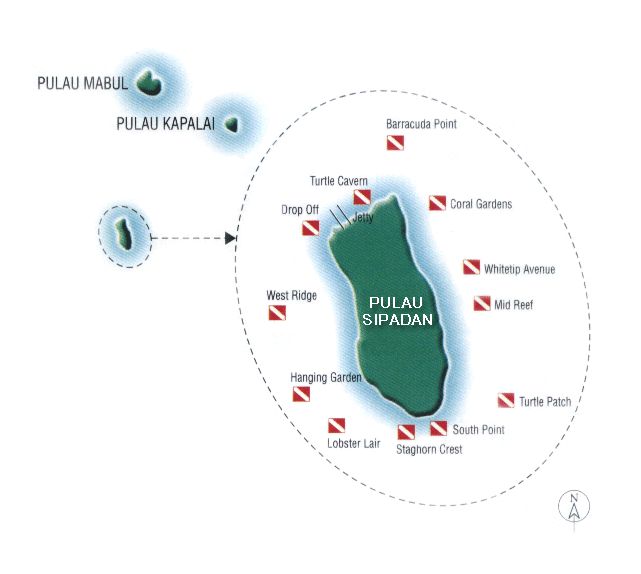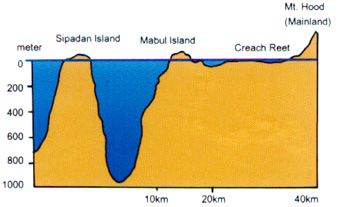Pulau
Sipadan (Sabah, East Malaysia)
Lying
just off the northest coast of Borneo is Sipadan, Malaysia's only oceanic island.
Shaped bu volcanic activity aeons ago, this 35 acre island rises about 700 metres
from the sea floor, attracting diverse marine life from the blackness of the open
sea. The spectaculardiving, unrivalled anywhere else in the country, has made
Malaysia one of the top diving destinations. Encounters with turtles, resident
schools of jacks and barracudas are almost assured around the tiny coral island.
A popular features of this island is the precipitous reef wall. Just a mere 8
metres from the dive station of the 'Sipadan Dive Lodge' the wall plunges to about
680 metres. Many divers have remarked that staying and diving on the island is
similar to doing so from a live-aboard ship. You enjoy the ease of multiple shore
and boat dives, with up to 5 dives per day. Sipadan
Island, formerly declared a bird sanctuary, is also home to monitor lizards, fruit
bats, the unique coconut crabs, and a luxuriant rainforest. About 47 known species
of birds frolic and feed about the natural vegetation, providing yet another attraction
for the visitor. |
|
Barracuda Point
The dive usually begins with the reef on your right, as you descend to the reef
top at about 6 to 8 metres, you will be greeted by schools of fusiliers and bumphead
wrasses congregating at the reef top. Growth of coral life extends to depths between
30 to 40 metres with huge barrel sponges, black coral trees, sea whips and soft
corals. Huge black marble stingrays, schools of surgeonfish, large tunas, manta
rays and clouds of pyramid butterflyfish greet the divers along the wall. Currents
that sweep the valley section of the site attracts school of batfish, white tip
sharks resting at the sandy bottom, barracudas, jacks, turtles, hammerhead sharks,
grey reef sharks (Carcharhinns anblyrhyrzchos) and or even the leopard shark (Sregosroma
fafciarnm) at the valley pass. As you ascend from the 18 metres-depth of the valley
to the gentle slopes at the side you can observe garden eels, triggerfish and
even exceptional macro marine animals like the leaf-fish, frogfish, blennies,
mantis shrimps and numerous nudibranchs. Hanging
Gardens
As the name suggests, this pretty dive site has a profusion of
colourful soft corals; some shaped like cauliflower plants and even grape-like
shapes growing from underhangs along the wall. The reef top begins at about 6
metres and plunges steeply to the depths. Here, you will encounter colourful crowd
of reef fish such as butterfly fish, angelfish, squirrelfish, boxfish and lots
of nudibranchs. Friendly sweetlips and groupers will curiously check out divers,
great for underwater photography. Small ledges encountered usually have small
shrimps wedged between bubble coral, fire tail gobis darting about their burrows
and the occasional lobster peering out between crevices. As the site is located
on the western part of the island, dives should be in the afternoon, with better
sunlight penetration. The
soft corals come alive and extend their body size by almost three times when currents
sweep the reef. Providing a breathtaking you. South
Point
The furthest dive site from the island jetty is a 10 minutes ride
in a dive boat. South Point, as the name suggests, is located at the southern
tip of the island and similar to barracuda Point as currents sweep across the
reef. Depending on the currents, it is best to start your dive with the reef on
your left. The reef topography follows a gentle slope from about 7 to 55 metres
at the sandy bottom shelf. Here,
chances are usually good to sight big animals like manta rays, leopard sharks,
Napoleon wrasses, groupers and a kaleidoscope of smaller reef fish. Assuming you
are diving with the wall on your left, you will come accross sea fans and sea
whip corals at 25 metres depth. You might also encounter a school of jacks prior
to a cloud of dark mass approaching - this is the largest school of barracudas
to be seen anywhere. The school usually swims against the current, and if approached
cautiously, will permit divers to swim alongside. Further along the sloping wall
at about 25 metres is a ledge with coral rubble, where white tip sharks and leopard
sharks rest on the bottom. If you dive this spot often and at the right time,
you may chance upon observing the mating ritual of white tip sharks. Turtle
Cavern
Much has been written about the turtle cavern, referring it to
as a Turtle Graveyard. In reality the turtles enter the cavern accidentally to
rest but get lost in the labyrinth of the tunnels, then become disorientated and
drown. The
cavern is situated at the northern end of the island right below several huts.
Divers are often warned during their first orientation dive that they are not
allowed to enter the cavern for their own safety. A signboard is also erected
at the entrance of the Turtle Cavern providing further warning, so a curious diver
won't end his stay in the cavern. However, visits into the cavern can be arranged
with a qualified divemaster leading 3 divers at a time. A cave diving certification
is offered for the adventurous who wish to explore the labyrinths.
The
dive begins along the wall of the drop-off and descends to about 20 metres. Depth
in the cavern is about 21 metres, and you find the various connecting caverns
rise to less than 4 metres from the surface. You will notice skeletal remains
of perished turtles scattered randomly on the silty cavern floor. There is even
the remains of what was once an egg-carrying female turtle. No coral growth is
observed in the cavern. The only life forms are schools of silver sweepers, soldier
fish and the flashlight fish. Getting
There
Pulau Sipadan is reached by flight from Sabah's capital, Kota Kinabalu,
then a connecting flight to Tawau, followed by a 2 1/2 hour drive to Semporna
and finally a 1 hour fast catamaran boat transfer to the island. To avoid disappointment,
prior bookings must be made. |


